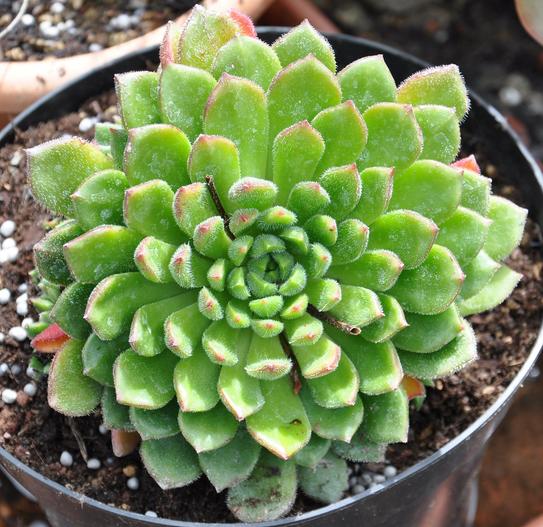Mexican Fire Cracker
(Echeveria setosa)
Mexican Fire Cracker (Echeveria setosa)
/
/

Jean-Michel Moullec
CC BY 2.0
Image By:
Jean-Michel Moullec
Recorded By:
Copyright:
CC BY 2.0
Copyright Notice:
Photo by: Jean-Michel Moullec | License Type: CC BY 2.0 | License URL: https://creativecommons.org/licenses/by/2.0/ | Uploader: Enez35 | Publisher: Flickr






















Estimated Native Range
Summary
Echeveria setosa, commonly known as Mexican Fire Cracker, is an evergreen succulent native to semi-desert habitats in Southern Mexico. This plant forms compact spherical rosettes reaching up to 4 cm (2 in) in height and 30 cm (12 in) in width. The rosettes are composed of fleshy, spoon-shaped leaves that are densely covered in white hairs, which serve to reflect sunlight and conserve water. The hairs, or glochids, can be irritating to the skin upon contact. In spring, Echeveria setosa produces striking 30 cm (12 in) long stalks bearing red flowers with yellow tips, which are particularly attractive to pollinators such as hummingbirds.
The Mexican Fire Cracker is valued for its unique texture and form, making it a popular choice for rock gardens, container displays, and as a ground cover in warm climates. Its drought tolerance and low water requirements make it an excellent plant for xeriscaping. It thrives in full sun to part shade and prefers well-draining soils. While it is hardy in subtropical regions like Southern California, it requires protection from frost and should be grown in containers or under glass with heat in colder climates. During the summer, it can be placed outdoors to enjoy the warmer weather. Echeveria setosa is relatively low-maintenance, but it can be susceptible to root rot if overwatered and may attract mealybugs.CC BY-SA 4.0
The Mexican Fire Cracker is valued for its unique texture and form, making it a popular choice for rock gardens, container displays, and as a ground cover in warm climates. Its drought tolerance and low water requirements make it an excellent plant for xeriscaping. It thrives in full sun to part shade and prefers well-draining soils. While it is hardy in subtropical regions like Southern California, it requires protection from frost and should be grown in containers or under glass with heat in colder climates. During the summer, it can be placed outdoors to enjoy the warmer weather. Echeveria setosa is relatively low-maintenance, but it can be susceptible to root rot if overwatered and may attract mealybugs.CC BY-SA 4.0
Plant Description
- Plant Type: Succulent
- Height: 0.2-0.3 feet
- Width: 0.667-1 feet
- Growth Rate: Slow
- Flower Color: Orange, Red, Yellow
- Flowering Season: Spring, Summer
- Leaf Retention: Evergreen
Growth Requirements
- Sun: Full Sun, Part Shade
- Water: Very Low, Low
- Drainage: Fast
Common Uses
Bird Garden, Border Plant, Drought Tolerant, Fire Resistant, Groundcover, Hummingbird Garden, Low Maintenance, Potted Plant, Rock Garden, Showy Flowers, Street Planting
Natural Habitat
Semi-desert habitats in Southern Mexico
Other Names
Common Names:
Scientific Names: Echeveria setosa , Sedum setosum
GBIF Accepted Name: Echeveria setosa Rose & Purpus